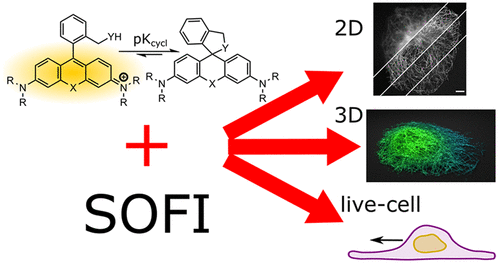Our official English website, www.x-mol.net, welcomes your
feedback! (Note: you will need to create a separate account there.)
Self-Blinking Dyes Unlock High-Order and Multiplane Super-Resolution Optical Fluctuation Imaging.
ACS Nano ( IF 15.8 ) Pub Date : 2020-06-22 , DOI: 10.1021/acsnano.0c04602 Kristin Grußmayer 1 , Tomas Lukes 1 , Theo Lasser 2, 3 , Aleksandra Radenovic 1
ACS Nano ( IF 15.8 ) Pub Date : 2020-06-22 , DOI: 10.1021/acsnano.0c04602 Kristin Grußmayer 1 , Tomas Lukes 1 , Theo Lasser 2, 3 , Aleksandra Radenovic 1
Affiliation

|
Most diffraction-unlimited super-resolution imaging critically depends on the switching of fluorophores between at least two states, often induced using intense laser light and specialized buffers or UV radiation. Recently, so-called self-blinking dyes that switch spontaneously between an open, fluorescent “on” state and a closed, colorless “off” state were introduced. Here, we exploit the synergy between super-resolution optical fluctuation imaging (SOFI) and spontaneously switching fluorophores for 2D and 3D imaging. SOFI analyzes higher order statistics of fluctuations in the fluorophore emission instead of localizing individual molecules. It thereby tolerates a broad range of labeling densities, switching behavior, and probe brightness. Thus, even dyes that exhibit spontaneous blinking characteristics that are not suitable or suboptimal for single molecule localization microscopy can be used successfully for SOFI-based super-resolution imaging. We demonstrate 2D imaging of fixed cells with almost uniform resolution up to 50–60 nm in 6th order SOFI and characterize changing experimental conditions. Next, we investigate volumetric imaging using biplane and eight-plane data acquisition. We extend 3D cross-cumulant analysis to 4th order, achieving super-resolution in 3D with up to 29 depth planes. Finally, the low laser excitation intensities needed for single and biplane self-blinking SOFI are well suited for live-cell imaging. We show the perspective for time-resolved imaging by observing slow membrane movements in cells. Self-blinking SOFI thus provides a more robust alternative route for easy-to-use 2D and 3D high-resolution imaging.
中文翻译:

自闪烁染料可解锁高阶和多平面超分辨率光学波动成像。
大多数衍射无限制的超分辨率成像严重取决于荧光团在至少两种状态之间的切换,这通常是使用强激光和专用缓冲液或紫外线辐射引起的。最近,引入了所谓的自闪烁染料,其在打开的荧光“开启”状态和关闭的无色“关闭”状态之间自发切换。在这里,我们利用超分辨率光学涨落成像(SOFI)与自发切换2D和3D成像荧光团之间的协同作用。SOFI分析了荧光团发射波动的高阶统计量,而不是定位单个分子。因此,它可以容忍各种范围的标记密度,开关行为和探头亮度。从而,即使是表现出不适合单分子定位显微镜检查或不理想的自发闪烁特性的染料,也可以成功用于基于SOFI的超分辨率成像。我们展示了固定细胞的二维成像,在6阶SOFI中分辨率几乎达到50-60 nm,并且表征了不断变化的实验条件。接下来,我们研究使用双平面和八平面数据采集的体积成像。我们将3D交叉累积量分析扩展到4阶,从而在多达29个深度平面的3D中实现超分辨率。最后,单平面和双平面自闪烁SOFI所需的低激光激发强度非常适合活细胞成像。我们通过观察细胞中缓慢的膜运动来显示时间分辨成像的角度。
更新日期:2020-07-28
中文翻译:

自闪烁染料可解锁高阶和多平面超分辨率光学波动成像。
大多数衍射无限制的超分辨率成像严重取决于荧光团在至少两种状态之间的切换,这通常是使用强激光和专用缓冲液或紫外线辐射引起的。最近,引入了所谓的自闪烁染料,其在打开的荧光“开启”状态和关闭的无色“关闭”状态之间自发切换。在这里,我们利用超分辨率光学涨落成像(SOFI)与自发切换2D和3D成像荧光团之间的协同作用。SOFI分析了荧光团发射波动的高阶统计量,而不是定位单个分子。因此,它可以容忍各种范围的标记密度,开关行为和探头亮度。从而,即使是表现出不适合单分子定位显微镜检查或不理想的自发闪烁特性的染料,也可以成功用于基于SOFI的超分辨率成像。我们展示了固定细胞的二维成像,在6阶SOFI中分辨率几乎达到50-60 nm,并且表征了不断变化的实验条件。接下来,我们研究使用双平面和八平面数据采集的体积成像。我们将3D交叉累积量分析扩展到4阶,从而在多达29个深度平面的3D中实现超分辨率。最后,单平面和双平面自闪烁SOFI所需的低激光激发强度非常适合活细胞成像。我们通过观察细胞中缓慢的膜运动来显示时间分辨成像的角度。









































 京公网安备 11010802027423号
京公网安备 11010802027423号